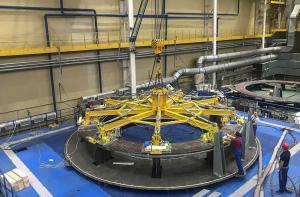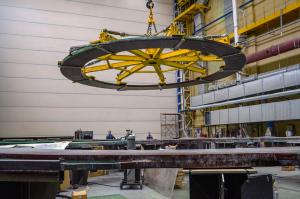Russia's ring coil
Entering the final sequence
23 Mar 2020
The smallest of ITER's poloidal field coils is entering the final sequence in a long series of activities that transform cable-in-conduit superconductor into a completed magnet ready for shipment to ITER.
One resin-hardened double pancake already sits on supports; a second is lowered by overhead crane. ITER's smallest poloidal field coil is formed from a stack of eight double pancakes. (The five other poloidal field coils are stacked from either six, eight or nine double pancakes.)
After successful winding, impregnation and joint assembly phases, the eight resin-hardened double pancakes of poloidal field coil #1 (PF1) are ready for stacking at the Sredne-Nevsky shipyard in Saint Petersburg. Situated on the Neva River, the shipyard enjoys direct access to the Baltic Sea and global shipping routes.
One by one, the double pancakes will be transported by overhead crane and assembled on the multi-stage assembly platform for PF1 coil fabrication that has been erected atop a stationary barge. At the end of the manufacturing process, the barge will be pulled backward out of the construction hall and into the river. There the coil and its platform will be transferred to a ship to begin the journey to ITER.
The stacked pancakes will be joined electrically before the entire assembly is transported to the resin impregnation station. Epoxy resin, injected over the course of several hours, fills all gaps and hardens the glass tape under the effect of heat and pressure. A "curing" phase completes the process, which confers rigidity to the coil and ensures electrical insulation.
During the final fabrication steps this year, the stacked double pancakes will be joined electrically, a second vacuum impregnation will be performed to harden the overall assembly, and additional components such as clamps, protection covers, and pipes will be added.
The PF1 magnet is the smallest of ITER's six poloidal field coils, which are installed outside of the toroidal field magnet structure to shape the plasma and contribute to its stability by keeping it away from the walls.
The manufacture of a poloidal field coil, nine meters in diameter and weighing 190 tonnes, has been a ten-year undertaking, from the time the original Procurement Arrangement was signed with the ITER Organization, to the moment the coil leaves the factory for ITER (schedule in the first quarter of 2021). The most important technologies for the fabrication of PF1 were developed at the Efremov Institute (JSC "NIIEFA"), which also designed, manufactured and tested a large part of the equipment.



